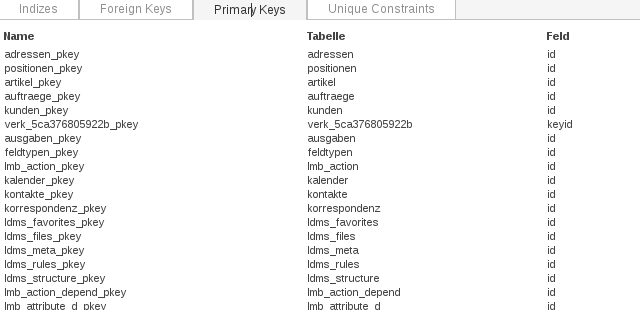Constraints
[Admin]->[Tools]->[Constraints] displays the indices used in LIMBAS. Use the tab to select:
- Indices
- Foreign Keys
- Primary Keys
- Unique Constraints
Indices

Indexing can improve the performance in searching or retrieving data. Displayed are manually created, as well as the automatically created indices. The displayed list can be sorted by column. An index can be deleted or a new one created. The column ‘used’ shows the current scans on this index. If, after a longer period of observation, the value is still zero, the index can be deleted. Unused indices can have a negative influence on the performance. You should not rush however, to delete an index, because it only is used effectively when sufficient data are available and a search has taken place. An index can be renewed. This can speed up a fragmented index, depending on the database.
Limbas automatically creates for all Links an index for the following fields:
- ID
- VERKN_ID
- SORT
Tabelle_A.ID -> Verkn_Tabelle.ID & Verkn_Tabelle.VERKN_ID -> Tabelle_B.ID
The SORT field is very important, because this index improves the performance for the creation of new data records in this table. If many links in this table are created at once the index is very advantageous.
During LIMBAS installation, indices are also created for the following table fields:
| Table | Field |
|---|---|
| lmb_gtab_groupdat | dat_id |
| lmb_indize_d | ref |
| lmb_indize_d | wid |
| lmb_indize_d | sid |
| lmb_indize_ds | ref |
| lmb_indize_ds | wid |
| lmb_indize_ds | sid |
| lmb_indize_f | sid |
| lmb_indize_f | sid |
| lmb_indize_f | sid |
| lmb_indize_fs | fid |
| lmb_indize_fs | wid |
| lmb_indize_fs | sid |
| lmb_indize_w | wid |
| lmb_indize_w | metaphone |
| lmb_select_d | dat_id |
| lmb_select_d | w_id |
| lmb_select_w | sort |
| lmb_select_w | pool |
| lmb_select_w | wert |
Note:
Any missing system indices can be created through System.
Foreign Keys

Foreign keys link to primary keys of another table. When linking two data sets, Limbas automatically creates a link table in the background. In this table, two foreign keys will be created, if you activated this function when creating the link (see referential integrity).
Primary Keys

The primary key identifies each dataset of a table. e.g. when two customers have the same name, you can distinguish them from each other using the primary key.
Unique Constraints

For 1:n links, instead of an index for the field VERKN_ID, a unique constraint (which already contains an index) will be created.


